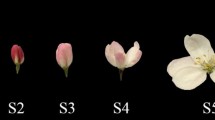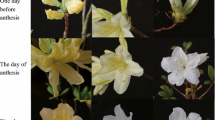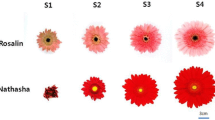Abstract
Main conclusion
This study confirmed pigment profiles in different colour groups, isolated key anthocyanin biosynthetic genes and established a basis to examine the regulation of colour patterning in flowers of Cymbidium orchid.
Cymbidium orchid (Cymbidium hybrida) has a range of flower colours, often classified into four colour groups; pink, white, yellow and green. In this study, the biochemical and molecular basis for the different colour types was investigated, and genes involved in flavonoid/anthocyanin synthesis were identified and characterised. Pigment analysis across selected cultivars confirmed cyanidin 3-O-rutinoside and peonidin 3-O-rutinoside as the major anthocyanins detected; the flavonols quercetin and kaempferol rutinoside and robinoside were also present in petal tissue. β-carotene was the major carotenoid in the yellow cultivars, whilst pheophytins were the major chlorophyll pigments in the green cultivars. Anthocyanin pigments were important across all eight cultivars because anthocyanin accumulated in the flower labellum, even if not in the other petals/sepals. Genes encoding the flavonoid biosynthetic pathway enzymes chalcone synthase, flavonol synthase, flavonoid 3′ hydroxylase (F3′H), dihydroflavonol 4-reductase (DFR) and anthocyanidin synthase (ANS) were isolated from petal tissue of a Cymbidium cultivar. Expression of these flavonoid genes was monitored across flower bud development in each cultivar, confirming that DFR and ANS were only expressed in tissues where anthocyanin accumulated. Phylogenetic analysis suggested a cytochrome P450 sequence as that of the Cymbidium F3′H, consistent with the accumulation of di-hydroxylated anthocyanins and flavonols in flower tissue. A separate polyketide synthase, identified as a bibenzyl synthase, was isolated from petal tissue but was not associated with pigment accumulation. Our analyses show the diversity in flower colour of Cymbidium orchid derives not from different individual pigments but from subtle variations in concentration and pattern of pigment accumulation.








Similar content being viewed by others
Abbreviations
- ANS:
-
Anthocyanidin synthase
- BBS:
-
Bibenzyl synthase
- CHS:
-
Chalcone synthase
- DFR:
-
Dihydroflavonol reductase
- FLS:
-
Flavonol synthase
- F3′H:
-
Flavonoid 3′ hydroxylase
- F3′5′H:
-
Flavonoid 3′5′ hydroxylase
- PKS:
-
Polyketide synthase
References
Albert NW, Lewis DH, Zhang H, Irving LJ, Jameson PE, Davies KM (2009) Light-induced vegetative anthocyanin pigmentation in Petunia. J Exp Bot 60:2191–2202
Albert NW, Arathoon S, Collette VE, Schwinn KE, Jameson PE, Lewis DH, Zhang H, Davies KM (2010) Activation of anthocyanin synthesis in Cymbidium orchids: variability between known regulators. Plant Cell Tissue Organ Cult 100:355–360
Albert NW, Lewis DH, Zhang H, Schwinn KE, Jameson PE, Davies KM (2011) Members of an R2R3-MYB transcription factor family in Petunia are developmentally and environmentally regulated to control complex floral and vegetative pigmentation patterning. Plant J 65:771–784
Albert NW, Davies KM, Lewis DH, Zhang H, Montefiori M, Brendolise C, Boase MR, Ngo H, Jameson PE, Schwinn KE (2014) A conserved network of transcriptional activators and repressors regulates anthocyanin pigmentation in eudicots. Plant Cell 26:962–980
Ampomah-Dwamena C, Dejnoprat S, Lewis D, Sutherland P, Volz RK, Allan AC (2012) Metabolic and gene expression analysis of apple (Malus × domestica) carotenogenesis. J Exp Bot 63:4497–4511
Arditti J (1992) Phytochemistry. In: Arditti J (ed) Fundamentals of orchid biology. Wiley, New York, pp 243–259
Austin MB, Noel AJP (2003) The chalcone synthase superfamily of type III polyketide synthases. Nat Prod Rep 20:79–110
Baudry A, Heim MA, Dubreucq B, Caboche M, Weisshaar B, Lepiniec L (2004) TT2, TT8, and TTG1 synergistically specify the expression of BANYULS and proanthocyanidin biosynthesis in Arabidopsis thaliana. Plant J 39:366–380
Bechtel H, Cribb P, Launert E (1992) The manual of cultivated orchid species, 3rd edn. The MIT Press, Cambridge
Boddu J, Svabek C, Sekhon R, Gevens A, Nicholson RL, Jones AD, Pedersen JF, Gustine DL, Chopra S (2004) Expression of a putative flavonoid 3′-hydroxylase in sorghum mesocotyls synthesizing 3-deoxyanthocyanidin phytoalexins. Physiol Mol Plant Pathol 65:101–113
Brugliera F, Barri-Rewell G, Holton TA, Mason JG (1999) Isolation and characterization of a flavonoid 3′-hydroxylase cDNA clone corresponding to the Ht1 locus of Petunia hybrida. Plant J 19:441–451
Cazzonelli CI, Pogson BJ (2010) Source to sink: regulation of carotenoid biosynthesis in plants. Trends Plant Sci 15:266–274
Chapple C (1998) Molecular-genetic analysis of plant cytochrome P450-dependent monooxygenases. Annu Rev Plant Physiol Plant Mol Biol 49:311–343
Chiou C-Y, Yeh K-W (2008) Differential expression of MYB gene (OgMYB1) determines color patterning in floral tissue of Oncidium Gower Ramsey. Plant Mol Biol 66:379–388
Chiou CY, Pan HA, Chuang YN, Yeh KW (2010) Differential expression of carotenoid-related genes determines diversified carotenoid coloration in floral tissues of Oncidium cultivars. Planta 232:937–948
Church GM, Gilbert W (1984) Genomic sequencing. Proc Natl Acad Sci USA 81:1991–1995
Collette VE, Jameson PE, Schwinn KE, Umaharan P, Davies KM (2004) Temporal and spatial expression of flavonoid biosynthetic genes in flowers of Anthurium andraeanum. Physiol Plant 122:297–304
Davies KM, Bradley JM, Schwinn KE, Markham KR, Podivinsky E (1993) Flavonoid biosynthesis in flower petal lines of lisianthus (Eustoma grandiflora Grise.). Plant Sci 95:67–77
Davies KM, Albert NW, Schwinn KE (2012) From landing lights to mimicry: the molecular regulation of flower colouration and mechanisms for pigmentation patterning. Funct Plant Biol 39:619–638
de Rosso VV, Mercadante AZ (2007) Identification and quantification of carotenoids, by HPLC-PDA-MS/MS, from Amazonian fruits. J Agric Food Chem 55:5062–5072
Feinberg AP, Vogelstein B (1983) A technique for radiolabeling DNA restriction endonuclease fragments to high specific activity. Anal Biochem 132:6–13
Feller A, Machemer K, Braun EL, Grotewold E (2011) Evolutionary and comparative analysis of MYB and bHLH plant transcription factors. Plant J 66:94–116
Fraser PD, Pinto ES, Holloway DE, Bramley PM (2000) Application of high-performance liquid chromatography with photodiode array detection to the metabolic profiling of plant isoprenoids. Plant J 24:551–558
Griesbach RJ (1984) Effects of carotenoid-anthocyanin combinations on flower color. J Hered 75:145–147
Griesbach RJ (1990) Flavonoid copigments and anthocyanin of Phalaenopsis schilleriana. Lindleyana 5:231–234
Grotewold E (2006) The genetics and biochemistry of floral pigments. Annu Rev Plant Biol 57:761–780
Guindon S, Gascuel O (2003) A simple, fast, and accurate algorithm to estimate large phylogenies by maximum likelihood. Syst Biol 52:696–704
Han Y, Ming F, Wang J, Ye M, Shen D (2005) A novel chalcone synthase gene from Phalaenopsis orchid that alters floral morphology in transgenic tobacco plants. Plant Mol Biol Rep 23:193–194
Han YY, Ming F, Wang JW, Wen JG, Ye MM, Shen DL (2006a) Cloning and characterization of a novel chalcone synthase gene from Phalaenopsis hybrida orchid flowers. Russ J Plant Physiol 53:223–230
Han YY, Ming F, Wang W, Wang JW, Ye MM, Shen DL (2006b) Molecular evolution and functional specialization of chalcone synthase superfamily from Phalaenopsis orchid. Genetica 128:429–438
Hartmann U, Sagasser M, Mehrtens F, Stracke R, Weisshaar B (2005) Differential combinatorial interactions of cis-acting elements recognized by R2R3-MYB, BZIP, and BHLH factors control light-responsive and tissue-specific activation of phenylpropanoid biosynthesis genes. Plant Mol Biol 57:155–171
Hasemann CA, Kurumbail RG, Boddupalli SS, Peterson JA, Deisenhofer J (1995) Structure and function of cytochromes-P450—a comparative analysis of 3 crystal structures. Structure 3:41–62
Helariutta Y, Elomaa P, Kotilainen M, Griesbach RJ, Schroder J, Teeri TH (1995) Chalcone synthase-like genes active during corolla development are differentially expressed and encode enzymes with different catalytic properties in Gerbera hybrida. Plant Mol Biol 28:47–60
Hendry GAF, Houghton JD, Brown SB (1987) The degradation of chlorophyll—a biological enigma. New Phytol 107:255–302
Hew CS (2001) Ancient Chinese orchid cultivation: a fresh look at an age-old practice. Sci Hortic 87:1–10
Hieber AD, Mudalige-Jayawickrama RG, Kuehnle AR (2006) Color genes in the orchid Oncidium Gower Ramsey: identification, expression, and potential genetic instability in an interspecific cross. Planta 223:521–531
Holton T, Cornish EC (1995) Genetics and biochemistry of anthocyanin biosynthesis. Plant Cell 7:1071–1083
Hörtensteiner S (2009) Stay-green regulates chlorophyll and chlorophyll-binding protein degradation during senescence. Trends Plant Sci 14:155–162
Hunter DA, Steele BC, Reid MS (2002) Identification of genes associated with perianth senescence in daffodil (Narcissus pseudonarcissus L. ‘Dutch Master’). Plant Sci 163:13–21
Johnson ET, Yi HK, Shin BC, Oh BJ, Cheong HS, Choi G (1999) Cymbidium hybrida dihydroflavonol 4-reductase does not efficiently reduce dihydrokaempferol to produce orange pelargonidin-type anthocyanins. Plant J 19:81–85
Kamffer Z, Bindon KA, Oberholster A (2010) Optimization of a method for the extraction and quantification of carotenoids and chlorophylls during ripening in grape berries (Vitis vinifera cv. Merlot). J Agric Food Chem 58:6578–6586
Kuehnle AR, Lewis DH, Markham KR, Mitchell KA, Davies KM, Jordan BR (1997) Floral flavonoids and pH in Dendrobium orchid species and hybrids. Euphytica 95:187–194
Lai YS, Shimoyamada Y, Nakayama M, Yamagishi M (2012) Pigment accumulation and transcription of LhMYB12 and anthocyanin biosynthesis genes during flower development in the Asiatic hybrid lily (Lilium spp.). Plant Sci 193:136–147
Liew C-F, Loh C-S, Goh C-J, Lim S-H (1998a) The isolation, molecular characterization and expression of dihydroflavonol 4-reductase cDNA in the orchid, Bromheadia finlaysoniana. Plant Sci 135:161–169
Liew CF, Goh CJ, Loh CS, Lim SH (1998b) Cloning and characterization of full-length cDNA clones encoding chalcone synthase from the orchid Bromheadia finlaysoniana. Plant Physiol Biochem 36:647–656
Liu XJ, Chuang YN, Chiou CY, Chin DC, Shen FQ, Yeh KW (2012) Methylation effect on chalcone synthase gene expression determines anthocyanin pigmentation in floral tissues of two Oncidium orchid cultivars. Planta 236:401–409
Ma H, Pooler M, Griesbach R (2008) Ratio of Myc and Myb transcription factors regulates anthocyanin production in orchid flowers. J Am Soc Hortic Sci 133:133–138
Ma H, Pooler M, Griesbach R (2009) Anthocyanin regulatory/structural gene expression in Phalaenopsis. J Am Soc Hortic Sci 134:88–96
Martens S, Forkmann G, Britsch L, Wellmann F, Matern U, Lukacin R (2003) Divergent evolution of flavonoid 2-oxoglutarate-dependent dioxygenases in parsley. FEBS Lett 544:93–98
Mori S, Otani M, Kobayashi H, Nakano M (2014) Isolation and characterization of the dihydroflavonol 4-reductase gene in the monocotyledonous ornamental Agapanthus praecox ssp. orientalis (Leighton) Leighton. Sci Hortic 166:24–30
Mudalige RG, Kuehnle AR, Amore TD (2003) Pigment distribution and epidermal cell shape in Dendrobium species and hybrids. HortScience 38:573–577
Mudalige-Jayawickrama RG, Champagne MM, Hieber AD, Kuehnle AR (2005) Cloning and characterization of two anthocyanin biosynthetic genes from Dendrobium orchid. J Am Soc Hortic Sci 130:611–618
Mullen W, Marks SC, Crozier A (2007) Evaluation of phenolic compounds in commercial fruit juices and fruit drinks. J Agric Food Chem 55:3148–3157
Nakatsuka A, Izumi Y, Yamagishi M (2003) Spatial and temporal expression of chalcone synthase and dihydroflavonol 4-reductase genes in the Asiatic hybrid lily. Plant Sci 165:759–767
Noda N, Kanno Y, Kato N, Kazuma K, Suzuki M (2004) Regulation of gene expression involved in flavonol and anthocyanin biosynthesis during petal development in lisianthus (Eustoma grandiflorum). Physiol Plant 122:305–313
Saito N, Toki K, Uesato K, Shigihara A, Honda T (1994) An acylated cyanidin glycoside from the red-purple flowers of Dendrobium. Phytochemistry 37:245–248
Schwinn KE, Davies KA (2004) Flavonoids. In: Davies K (ed) Plant pigments and their manipulation, vol 14., Blackwell PublishingOxford, UK, pp 92–149
Schwinn K, Venail J, Shang YJ, Mackay S, Alm V, Butelli E, Oyama R, Bailey P, Davies K, Martin C (2006) A small family of MYB-regulatory genes controls floral pigmentation intensity and patterning in the genus Antirrhinum. Plant Cell 18:831–851
Sharma M, Cortes-Cruz M, Ahern KR, McMullen M, Brutnell TP, Chopra S (2011) Identification of the pr1 gene product completes the anthocyanin biosynthesis pathway of maize. Genetics 188:69–79
Shirley BW (1996) Flavonoid biosynthesis: ‘new’ functions for an old pathway. Trends Plant Sci 1:377–382
Sugiyama A, Kinoshita M, Kako S, Ohno H, Sakakibara K (1977) Studies on the flower colour of Cymbidium. I. Properties of anthocyanins in the flowers. J Japan Soc Hortic Sci 46:72–80
Tanaka Y, Katsumoto Y, Brugliera F, Mason J (2005) Genetic engineering in floriculture. Plant Cell Tissue Organ Cult 80:1–24
Tanaka Y, Sasaki N, Ohmiya A (2008) Biosynthesis of plant pigments: anthocyanins, betalains and carotenoids. Plant J 54:733–749
Tatsuzawa F, Saito N, Yokoi M (1996) Anthocyanins in the flowers of Cymbidium. Lindleyana 11:214–219
Tatsuzawa F, Saito N, Seki H, Hara R, Yokoi M, Honda T (1997) Acylated cyanidin glycosides in the red-purple flowers of Phalaenopsis. Phytochemistry 45:173–177
Thammasiri K, Tang CS, Yamamoto HY, Kamemoto H (1986) Carotenoids and chlorophylls in yellow flowered Dendrobium species. Lindleyana 1:215–218
Tian Q, Giusti MM, Stoner GD, Schwartz SJ (2005) Screening for anthocyanins using high-performance liquid chromatography coupled to electrospray ionization tandem mass spectrometry with precursor-ion analysis, product-ion analysis, common-neutral-loss analysis, and selected reaction monitoring. J Chromatogr 1091:72–82
Tomlinson PC (1985) Cymbidiums: a cultural guide, 2nd edn. Wellington Orchid Society, Wellington
Turnbull JJ, Nakajima J, Welford RWD, Yamazaki M, Saito K, Schofield CJ (2004) Mechanistic studies on three 2-oxoglutarate-dependent oxygenases of flavonoid biosynthesis—anthocyanidin synthase, flavonol synthase, and flavanone 3 ß-hydroxylase. J Biol Chem 279:1206–1216
Wang JW, Ming F, Han YY, Shen DL (2006) Flavonoid 3′, 5′-hydroxylase from Phalaenopsis: a novel member of cytochrome P450s, its cDNA cloning, endogenous expression and molecular modeling. Biotechnol Lett 28:327–334
Weiss D (2000) Regulation of flower pigmentation and growth: multiple signaling pathways control anthocyanin synthesis in expanding petals. Physiol Plant 110:152–157
Whang S, Um W, Song I-J, Lim P, Choi K, Park K-W, Kang K-W, Choi M, Koo J (2011) Molecular analysis of anthocyanin biosynthetic genes and control of flower coloration by flavonoid 3′, 5′-hydroxylase (F3′5′H) in Dendrobium moniliforme. J Plant Biol 54:209–218
Woltering EJ, Somhorst D (1990) Regulation of anthocyanin synthesis in Cymbidium flowers: effects of emasculation and ethylene. J Plant Physiol 136:295–299
Acknowledgments
The authors thank West Coast Orchids, Auckland; Kiwi Orchids, Nelson and Airborne Cymbidiums, Auckland, New Zealand for supplying the flower stems used in these experiments, Stephen Bloor, Ewald Swinny, and Kevin Mitchell (Industrial Research Ltd) and Nigel Joyce (Plant and Food Research) for their assistance with pigment analysis and identification, the members of the Cymbidium Orchid Group for their support and interest in this project. LW thanks Professor Michael McManus (Massey University) for supervision and guidance during her MSc studies.
Author information
Authors and Affiliations
Corresponding author
Additional information
Special topic: Anthocyanins. Guest editor: Stefan Martens.
Electronic supplementary material
Supplementary Table ST1 Oligonucleotide primers used to amplify Cymbidiumflavonoid biosynthetic genes
Supplementary Fig. S1 Comparison of the deduced amino acid sequence of ChF3′H with other F3′H proteins. Multiple sequence alignments were generated by the Clustal W2.1 program. GenBank accession number is listed after plant species. Numbers indicate position of amino acid from the N-terminus. ChF3′H sequence is listed in pink colour font. The conserved F3′H regions are highlighted in blue boxes, and the conserved domains found in the CYP450 family proteins are highlighted in purple boxes. The conserved amino acids are labelled with asterisks, the highly conservative changes are labelled with double dots, and the conservative changes are labelled with dots
Supplementary Fig. S2 Comparison of the deduced amino acid sequence of ChDFR amplified from Cymbidium ‘Clarisse Austin South Pacific’ (KM186174) with the published DFR protein (AAC17843). Numbers indicate position of amino acid from the N-terminus. The conserved amino acids are labelled with asterisks, the highly conservative changes are labelled with double dots, and the conservative changes are labelled with dots. Different amino acid between the DFR sequence from Cymbidium ‘CASP’ and the published DFR sequence are highlighted in red
Supplementary Fig. S3 Northern blot analysis of five flavonoid biosynthetic genes in leaf tissues of various Cymbidium cultivars. ‘Jungfrau dos Pueblos’ (‘JDP’); ‘Lisa Rose Flamingo’ (‘LRF’); ‘Clarisse Austin South Pacific’ (‘CASP’); ‘Virgin’ (‘V’). Twenty micrograms of total RNA from each leaf sample was loaded on each lane. The lower panel showed the ribosomal RNA stained with ethidium bromide as a loading control
Supplementary Fig. S4 Northern blot showing spatial and temporal expression of BBS in floral and leaf tissues of Cymbidium cultivars ‘Vanguard Mas Beauty’ (‘VMB’), ‘Narella Jennifer Gail’ (‘NJG’), ‘Jungfrau dos Pueblos’ (‘JDP’), ‘Big Chief Kirawee’ (‘BCK’). S, sepal; P, petal; L, labellum. Developmental stages are labelled 1 to 6. The bottom panels indicate the loading of RNA stained using ethidium bromide staining of rRNA bands
Supplementary Fig. S5 Pigment concentration (mg or µg g−1DW) for anthocyanins, flavonoids, carotenoids and chlorophyll in labellum tissue of flowers from the different Cymbidium orchids characterised in this study. ‘Clarisse Austin South Pacific’ (‘CASP’); ‘Lisa Rose Flamingo’ (‘LRF’); ‘Gymer Cooksbridge’ (‘GC’); ‘Arcadian Sunrise’ (‘AS’); ‘Big Chief Kirawee’ (‘BCK’); ‘Vanguard Mas Beauty’ (‘VMB’); ‘Virgin’ (‘V’); ‘Jungfrau dos Pueblo’s (‘JDP’). Data presented are mean values ± SEM, n = 3 for the anthocyanins and flavonoids, n = 2 for the carotenoids and chlorophyll measurements
Supplementary Fig. S6 Carotenoid profiles presented as a relative proportion of total carotenoids detected in petal tissue of the yellow and green flower colour cultivars. Data presented are the mean values for two independent petal tissue samples
Below is the link to the electronic supplementary material.
Rights and permissions
About this article
Cite this article
Wang, L., Albert, N.W., Zhang, H. et al. Temporal and spatial regulation of anthocyanin biosynthesis provide diverse flower colour intensities and patterning in Cymbidium orchid. Planta 240, 983–1002 (2014). https://doi.org/10.1007/s00425-014-2152-9
Received:
Accepted:
Published:
Issue Date:
DOI: https://doi.org/10.1007/s00425-014-2152-9




